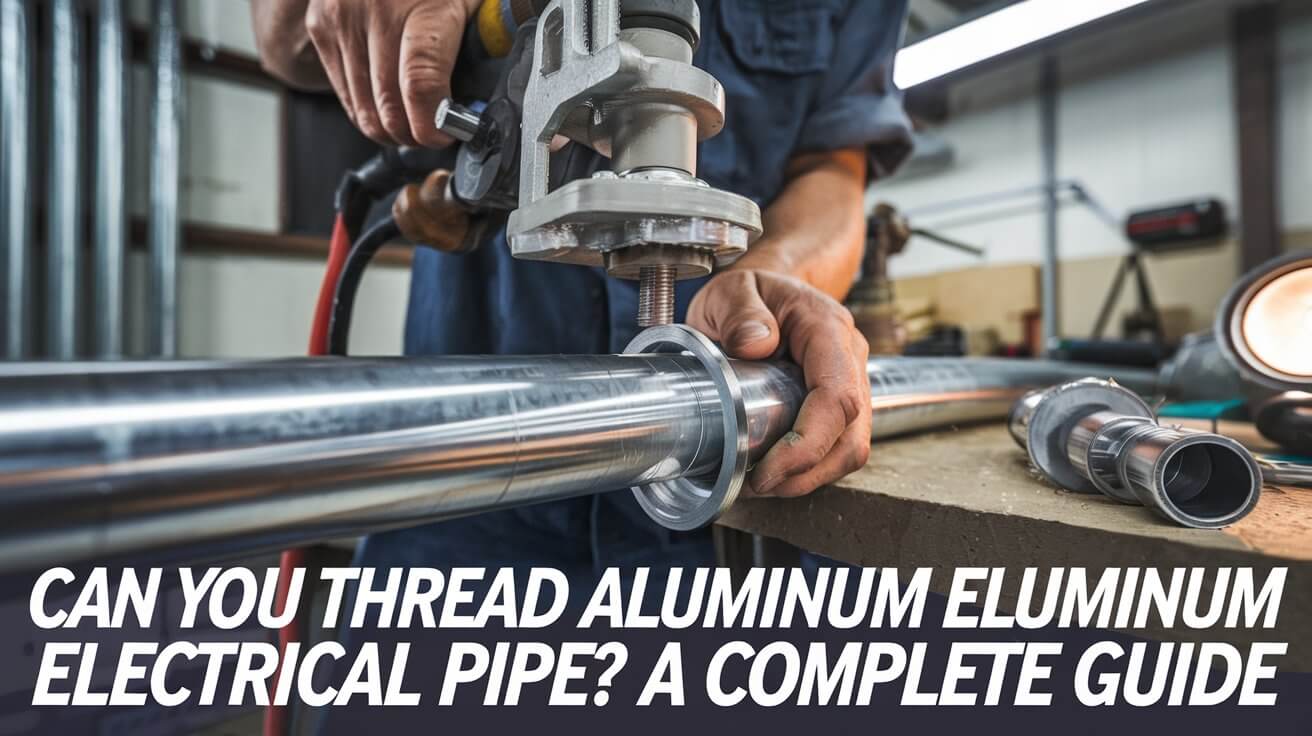Can You Thread Aluminum Electrical Pipe? A Complete Guide

Threading aluminum electrical pipes is a commonly asked question among electricians and DIY enthusiasts alike. The short answer is yes, you can thread aluminum electrical pipes, but it requires the right tools, techniques, and a bit of extra care compared to other materials like steel. Aluminum’s softer nature makes it more prone to issues like clogging and deforming, but with proper methods, threading can be achieved effectively. This article will cover all aspects of threading aluminum electrical pipes, offering a detailed guide, tools needed, and best practices.
What is Threading in Electrical Conduits?
Threading refers to the process of creating spiral ridges (threads) on the ends of electrical conduits to enable secure connections between pipes, fittings, and other electrical components. Electrical conduit pipes, like those made from steel or aluminum, are often threaded to allow for tight, sealed joints. Threading is essential for maintaining the integrity of electrical systems, ensuring that wires are safely enclosed, and providing protection from the environment.
Different types of conduits exist, such as rigid metal conduit (RMC), electrical metallic tubing (EMT), and aluminum conduit, each with its own advantages. Aluminum conduits are especially popular in certain environments because they are lightweight, corrosion-resistant, and easy to work with.
Can You Thread Aluminum Electrical Pipe?
Yes, threading aluminum electrical pipe is possible and widely practiced, especially in environments where aluminum conduits are preferable due to their corrosion resistance and lightweight nature. However, threading aluminum differs from threading steel because aluminum is a softer metal, prone to binding, deforming, and clogging tools if not done correctly.
When threading aluminum, using the right tools, including sharp dies and lubricants, is critical to prevent damage to the pipe. The softer metal can easily be deformed, and without proper care, the threads might not be as strong or accurate. Using lubricants like Penatrox can help reduce friction, and cleaning your threading tools frequently will prevent chips from building up.
Why Thread Aluminum Electrical Pipe?
Threading aluminum electrical pipes is common in certain applications where threaded connections are needed to form secure, watertight seals. The use of threaded aluminum conduits is ideal in locations prone to moisture or corrosion, such as outdoor installations or marine environments.
Advantages of Threading Aluminum Conduits:
- Lightweight: Aluminum is much lighter than steel, making it easier to work with, especially in large installations.
- Corrosion-Resistant: Aluminum naturally forms a protective oxide layer that prevents rust, making it ideal for environments exposed to moisture or chemicals.
- Easy to Handle: Its softer nature means that cutting and threading aluminum can be faster and require less effort compared to harder metals.
Disadvantages:
- Prone to Deformation: Aluminum can easily deform under pressure, which makes careful handling necessary during threading.
- Binding Issues: Without proper lubrication, the softer aluminum material can bind in the threading tools.
Tools and Equipment Needed for Threading Aluminum Electrical Pipe
Successfully threading aluminum conduit requires the right tools and proper techniques. Given aluminum’s unique properties, here’s a breakdown of the equipment you’ll need.
Cutting Tools
Before threading, the aluminum pipe must be cut to the correct length. Using a proper pipe cutter designed for soft metals is essential to ensure the cut is clean and precise. A poorly cut pipe can lead to inaccurate threads or even damage the threading die.
Threading Tools
Both manual and powered threading tools can be used for aluminum pipes. Threading dies specifically designed for non-ferrous metals, like aluminum, are recommended. A die with sharp, clean edges will create smoother threads and reduce the chances of clogging or binding.
- Manual Threader: Works well for small jobs or when only a few threads are needed.
- Electric Threader: Ideal for larger jobs or when precision and speed are necessary.
Lubricants
Aluminum can bind or seize during the threading process due to its softness. To prevent this, use lubricants specifically designed for threading softer metals. Penatrox or similar anti-oxidizing lubricants help reduce friction and prevent the buildup of metal shavings that can clog the threading tool.
Safety Gear
Threading aluminum can produce sharp edges and fine metal shavings, so wearing safety gear such as gloves, goggles, and proper clothing is important. Also, because aluminum is non-magnetic, grounding yourself and the pipe during electrical work is necessary to prevent accidents.
Step-by-Step Guide to Thread Aluminum Electrical Conduit
Threading aluminum conduit requires a bit of patience and care. Follow this step-by-step guide for best results:
Step 1: Measuring and Marking
Before you begin threading, measure the length of conduit you need, accounting for the threaded sections that will connect to fittings. Mark the pipe carefully with a straight edge to ensure an even cut.
Step 2: Cutting the Conduit
Use a pipe cutter designed for aluminum or other soft metals. Rotate the cutter around the conduit, tightening slightly after each rotation until the pipe is cut. Make sure the cut is clean and straight, as an uneven cut can lead to poor threads.
Step 3: Deburring the Edges
After cutting, the pipe will have sharp edges that need to be smoothed out. Use a deburring tool to remove burrs from both the inside and outside of the pipe. This will ensure that the threads are clean and precise.
Step 4: Using Threading Dies and Lubricants
Fit the correct size die into your threading tool. Apply lubricant generously to both the pipe and the die to reduce friction and prevent clogging. Rotate the die slowly to start the thread, ensuring it stays straight and centered on the pipe. Once the thread is started, continue applying steady pressure and additional lubricant as needed.
Step 5: Securing and Testing the Fittings
Once the threads are cut, use a fitting to test the connection. The fitting should screw on easily but snugly, without forcing it. If the thread feels loose, it may be under-threaded, and if it binds, it could be over-threaded. Make adjustments as necessary.
Aluminum vs. Steel Electrical Conduits: Which Is Easier to Thread?
Both aluminum and steel conduits are widely used in electrical work, but they differ significantly in how they’re threaded.
Durability and Flexibility
Aluminum is much easier to handle and cut than steel, making it a preferred choice in applications where weight and flexibility are factors. Steel, on the other hand, is more durable and less prone to deformation, which makes threading steel less risky for certain heavy-duty applications.
Material-Specific Challenges
While steel is more durable, aluminum is more prone to binding and clogging during the threading process. Extra care must be taken when threading aluminum to ensure that tools do not become clogged, and that the threads are not over-cut.
Tips and Best Practices for Threading Aluminum Electrical Pipe
To achieve the best results when threading aluminum conduit, follow these best practices:
Using Proper Lubricants
Use a lubricant designed specifically for aluminum or soft metals. This reduces the risk of binding and helps maintain tool efficiency.
Preventing Clogging and Damage to Tools
Since aluminum is softer, it can create small chips that clog threading dies. Clean your tools frequently during the process to avoid this.
Avoiding Over-threading or Deforming the Pipe
Over-threading can weaken the pipe and make it prone to failure. Use a depth gauge or follow manufacturer guidelines to ensure you’re cutting the correct number of threads.
Threaded Aluminum Conduits in Electrical Codes and Standards
Threaded aluminum conduits must adhere to local and national electrical codes. In the U.S., the National Electrical Code (NEC) provides guidelines on how and where aluminum conduits can be used. Aluminum is often preferred in outdoor environments or areas prone to corrosion. However, some codes may specify certain fittings or treatment methods for aluminum to prevent corrosion at the threaded joints.
Common Issues and How to Address Them
When threading aluminum electrical pipe, a few issues may arise, such as:
Clogged Dies or Threaders
Aluminum’s softer nature means that small chips can easily clog threading dies. To prevent this, clean your tools regularly and apply plenty of lubricant during the process.
Weak Threads or Deformation
If too much pressure is applied while threading, the aluminum pipe may become deformed, weakening the threads. To avoid this, thread the pipe slowly and evenly, applying only as much pressure as needed to cut the thread.
Corrosion Risks
Although aluminum is corrosion-resistant, threaded joints can still be vulnerable. Use anti-oxidizing compounds like Penatrox to protect the threads from corrosion over time.
Alternatives to Threading Aluminum Electrical Pipe
If threading is not feasible or desirable, there are alternative methods for connecting aluminum electrical pipes:
Compression Fittings
Compression fittings offer a strong and reliable way to connect aluminum conduits without the need for threading. They are easy to install and can be reused if necessary.
Push-on and Set Screw Fittings
Push-on and set screw fittings are another option, providing a secure connection without threading. These fittings are ideal for quick installations and repairs.
Maintenance and Longevity of Threaded Aluminum Conduits
Long-term Care and Inspection
Threaded aluminum conduits should be inspected regularly to ensure the threads remain strong and free from corrosion. Periodic reapplication of anti-oxidizing compounds can help extend the lifespan of threaded connections.
Identifying Wear and Tear
Look for signs of wear, such as loose fittings or visible corrosion, particularly at the threaded joints. If issues are identified early, repairs can prevent system failures.
Future Trends in Aluminum Electrical Conduits
As the demand for lightweight, corrosion-resistant materials grows, aluminum electrical conduits are likely to remain popular. Advances in conduit manufacturing and threading techniques maybecome even more reliable and efficient. As technologies evolve, it’s likely we’ll see improvements in both the quality of aluminum conduits and the tools available for threading them. Expect future innovations to focus on making the process easier, faster, and more precise.
Conclusion: Is Threading Aluminum Electrical Pipe Worth It?
Threading aluminum electrical pipes is not only possible but can be a practical solution for many electrical installations. Aluminum is lightweight, corrosion-resistant, and easy to work with, making it a popular choice in certain environments. However, it requires a bit more care than threading harder materials like steel due to its softness and tendency to clog tools.
If you’re considering aluminum electrical conduits, be sure to invest in the right tools, use lubricants, and follow best practices to ensure successful threading. While there are alternatives like compression or push-on fittings, threaded aluminum conduits provide a reliable, durable option when done correctly. With proper handling and maintenance, threaded aluminum pipes can offer long-lasting performance in both residential and commercial electrical systems.
By understanding the nuances of threading aluminum and following the step-by-step process outlined in this guide, you can ensure a smooth, secure, and professional installation for your electrical conduit system.



